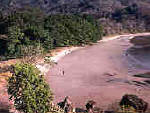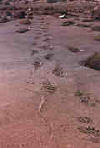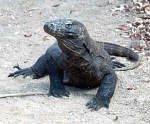

The next day, dragons forgotten, we anchored in a beautiful, isolated and protected bay on the south end of Rinca Island. The site we had come to dive here was named, ominously, Cannibal Rock. We made our morning dives, and during a long surface interval after lunch, four of us requested a lift on the dinghy to the nearby beach where we meant to pass the time beachcombing and exploring. A lovely stretch of white sand welcomed us, wave washed and sun warmed at high tide. The ocean had left gifts for us in its endless shell game and we delightedly set out to gather in the largess as the tide began its retreat.
We found much more than we expected; the dragons of Komodo are excellent swimmers and I have no idea why I had expected them to stay on the island for which they are named. Straight down the beach, just above the waterline, was the unmistakable spoor of a great lizard, its huge claws gouging the sand and its tail intersecting the prints in sinuous, curving swathes. I began to identify with the convicts exiled on Komodo! The luxuriant tree line reached to the beach, and we found more tracks wandering in and out of the brush.
Recalling our guide, we found a long stout stick, presented it to our most virile and fearless companion, and continued our shell shopping with one ear and eye tuned always to the tree line. At the end of the beach a rocky headland rose high above the surrounding terrain and a pair of ospreys soared above in watchful circles. As we began to ascend the steep slope we encountered the sign that sent us scurrying back to the open beach: large piles of white hair-filled excrement!


The first of us to reach the beach again cried out loudly, "DRAGON!" and we all strained to see the direction her finger indicated. At the far end of the beach stretched a dragon, its head raised alertly and returning our interest. A hundred yards away, it was still easy to see the intense interest we generated. He slightly raised his tail, and as we began to walk toward him, he moved into the trees. When we reached the place he had been, we found a large area of the sand deeply disturbed by what must have been a ferocious struggle between predator and prey. There was no sign of the prey beyond the track of a pig. We could hear the movements of the dragon deep in the brush, moving away from us. He had no taste for a close encounter with humans.
When the dinghy returned for us we were still chatting excitedly about our adventure, and eager to unwrap the next gift from the islands of Indonesia. Donning my wetsuit for the afternoon dive, I considered the wisdom of the little flying lizard of Komodo Island who grew "wings" to escape danger. And then with a great shout of joy, choosing risk, I rolled backwards off of the dinghy into the cold waters above Cannibal Rock.


Thank God for islands, for they harbor, protect and nurture the wild things of the earth. These natural refuges, guarded by vast and fierce ocean moats, have assured that now, as in ages past, mariners can say with awe and certainty, "Captain, here there be dragons!"